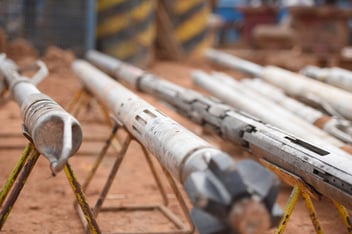The increasing demand for durable, high-performance components across industries such as aerospace, energy and advanced engineering has driven the evolution of coating technologies. Components with intricate designs, internal channels and high aspect ratio bores require coatings that provide uniform protection without compromising precision. Traditional coatings like Hard Chrome Plating (HCP) and High-Velocity Oxygen Fuel (HVOF) thermal spray often struggle with these complex geometries due to their inherent line-of-sight limitations.
Chemical Vapour Deposition (CVD) stands out as the superior solution. By enabling uniform, non-line-of-sight deposition, CVD ensures comprehensive protection against wear, corrosion and erosion, even in the most complex geometries. This guide explores how CVD coatings, particularly Hardide’s advanced tungsten carbide-based coatings, deliver exceptional performance and longevity for intricate components.
The challenges of coating complex geometries
Components with internal cavities, sharp edges and recessed features pose difficulties and challenges when it comes to protective coatings. These complex geometries are particularly difficult because many traditional methods rely on line-of-sight application techniques. High-Velocity Oxygen Fuel (HVOF) thermal spray, for example, requires direct access to the target surface, making it nearly impossible to coat internal cavities, narrow bores and recessed features uniformly.
Due to their intricate shapes, components like hydraulic actuators, oil and gas valves and aerospace gearbox shafts often suffer from uneven protection, leaving some areas vulnerable to wear and corrosion while others receive excessive material buildup. This inconsistency both compromises durability and necessitates costly post-processing, such as grinding, to meet tight dimensional tolerances.
Surface adhesion is another key challenge when coating complex geometries. Sharp edges, internal surfaces and varying substrate materials can create adhesion difficulties, increasing the risk of delamination and premature coating failure. HVOF coatings, for instance, adhere mechanically rather than metallurgically, making them prone to chipping and peeling under mechanical stress. This is particularly problematic for components exposed to high loads and dynamic forces, such as aircraft landing gear or pump impellers, where a weakly bonded coating can lead to catastrophic failure.
How CVD overcomes these challenges with ease
Chemical Vapour Deposition (CVD) is an advanced coating technology that produces uniform, high-performance coatings by depositing material atom-by-atom from a gas phase. This process ensures exceptional hardness, wear resistance and corrosion protection, making it a superior alternative to traditional coatings like Hard Chrome Plating (HCP) and High-Velocity Oxygen Fuel (HVOF) thermal spray. These attributes make CVD particularly effective for coating complex geometries for a number of reasons.
Non-line-of-sight coverage
Unlike line-of-sight processes, CVD coatings are deposited atom-by-atom from a gas phase, ensuring full coverage on both internal and external surfaces. This makes it the ideal solution for a wide array of complex components.
- Hydraulic actuators and gearbox shafts
- Valves, pumps and impellers
- Downhole drilling tools
- Extrusion dies and tooling for abrasive materials
Superior bond strength
CVD coatings achieve metallurgical bonding with the substrate, creating a strong, durable interface that resists delamination, even under extreme loads and cyclic fatigue. Unlike mechanically adhered coatings like HVOF, which can chip or peel over time, CVD forms an atomic-level bond that enhances structural integrity.
Uniform coating deposition
CVD ensures uniform coverage on intricate geometries, addressing the inconsistencies of traditional coatings like HVOF, which struggle with recessed and internal surfaces. This uniformity eliminates weak spots that can lead to premature wear or failure. This makes it ideal for components such as precision valves to reduce post-processing requirements and improve overall efficiency.
CVD’s geometry coverage and more compared to traditional coatings
| Feature | CVD Coatings | HVOF Thermal Spray | Hard Chrome Plating |
| Geometry Coverage | Uniform, coats internal and complex surfaces | Line-of-sight only | Line-of-sight, thickest at edges |
| Bond Strength | Metallurgical bond | Mechanical adhesion | Mechanical adhesion |
| Corrosion Resistance | Pore-free, highly resistant | Porous, requires sealing | Cracks and porosity present |
| Wear Resistance | Up to 24x better than HCP | Good but prone to binder wear | Moderate but micro-cracks lead to failure |
| Surface Finish | Smooth, polishable | Requires post-coating grinding | Requires grinding and sealing |
| Environmental Impact | REACH-compliant, no hazardous by-products | Uses cobalt binder, which can leach | Contains toxic hexavalent chromium |
CVD across industries for intricate components
Aerospace & defence
- CVD coatings provide uniform protection on intricate aerospace components, such as turbine blades and actuator housings, where traditional coatings struggle to reach internal surfaces.
- CVD coatings have been adopted as a REACH-compliant replacement for HCP on landing gear, ensuring consistent coverage across complex geometries and reducing maintenance costs.
Oil & gas
- Downhole drilling tools with intricate flow paths benefit from CVD’s ability to coat internal surfaces evenly, preventing localised wear and erosion.
- Valves and pumps, which feature complex passageways, are fully protected by CVD, improving longevity and resistance to abrasive and corrosive environments.
Industrial & manufacturing
- Extrusion dies and moulds with fine cavities and intricate shapes receive consistent CVD coatings, ensuring extended durability and reducing costly refinishing.
- Bearings, precision rollers, and sliding components maintain optimal performance as CVD provides an even, wear-resistant layer, even in hard-to-reach areas.
The future of precision coatings for complex geometry components
CVD has transformed the landscape of industrial coatings, offering unmatched precision, durability, and environmental compliance. Its ability to coat intricate and internal surfaces with a dense, uniform layer makes it the leading choice for components requiring high wear, erosion, and corrosion resistance.
For industries seeking to extend component lifespan, reduce maintenance costs, and enhance performance, Hardide CVD coatings provide a proven, high-performance solution. To learn more about how CVD coatings can optimise your critical components, read our guide below.







